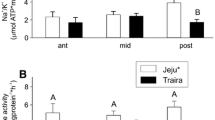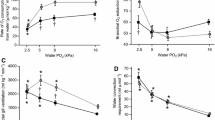Abstract
The pleopod ventilatory activity of the tube-dwelling amphipods Corophium volutator (Pallas) and C. arenarium Crawford is intermittent. Unlike the free-living amphipod Marinogammarus obtusatus (Dahl), which increases its rate of pleopod beating, the pleopod beat rate of both Corophium species is unaffected by low oxygen concentrations. However, the nature of the intermittent ventilation rhythm is altered so that, at low oxygen concentrations, the pleopods of Corophium beat almost continuously. It is suggested that the intermittent ventilation of Corophium can be interpreted as an adaptation to a tubicolous existence. The peracaridean Tanais chevreuxi Dollfus has 2 independent ventilatory systems, the maxilliped epipodites and the pleopods. The former, which respond to low oxygen concentrations, are thought to be the principal respiratory organs of T. chevreuxi, while the pleopods, which show no response to low oxygen tensions, are believed to be primarily concerned in filter feeding.
Similar content being viewed by others
Literature cited
Dam, L. van: On the utilisation of oxygen and the regulation of breathing in some aquatic animals. Dissert. 138 pp. Groningen: Volharding 1938.
Devine, C. E.: Ecology of Callianassa filholi Milne-Edwards 1878 (Crustacea, Thalassinidea). Trans. R. Soc. N.Z. (Zool.) 8, 93–110 (1966).
Ellenby, C.: Body size in relation to oxygen consumption and pleopod beat in Ligia oceanica. J. exp. Biol. 28, 492–507 (1951).
Farley, R. D. and J. F. Case: Perception of external oxygen by the burrowing shrimps Callianassa californiensis Dana and C. affinis Dana. Biol. Bull. mar. biol. Lab., Woods Hole 134, 261–265 (1968).
Fox, H. M. and M. L. Johnson: The control of respiratory movements in crustacea by oxygen and carbon dioxide. J. exp. Biol. 11, 1–10 (1934).
— and J. Sidney: The influence of dissolved oxygen on the respiratory movements of caddis larvae. J. exp. Biol. 30, 235–238 (1953).
Gamble, J. C.: An anaesthetic for Corophium volutator (Pallas) and Marinogammarus obtusatus (Dahl), Crustacea, Amphipoda. Experientia 25, 539–540 (1969).
Gamble, J. C.: Anaerobic survival of the crustaceans Corophium volutator, C. arenarium and Tanais chevreuxi. J. mar. biol. Ass. U.K. (In press). (1970).
Hall, V. E.: The muscular activity and oxygen consumption of Urechis caupo. Biol. Bull. mar. biol. Lab., Woods Hole 61, 400–416 (1931).
Johnson, M. L.: The control of respiratory movements in crustacea by oxygen and carbon dioxide. II. J. exp. Biol. 13, 467–475 (1936).
Kensler, C. B.: Desiccation resistance of intertidal crevice species as a factor in their zonation. J. Anim. Ecol. 36, 391–406 (1967).
Lang, K.: The post marsupial development of the Tanaidacea. Ark. Zool. 4, 409–422 (1953).
Lindroth, A.: Studien über die respiratorischen Mechanismen von Nereis virens Sars. Zool. Bidr. Upps. 17, 367–497 (1938).
McLusky, D. M.: The oxygen consumption of Corophium volutator in relation to salinity. Comp. Biochem. Physiol. 29, 743–753 (1969).
Magnum, C. P.: Activity patterns in metabolism and ecology of polychaetes. Comp. Biochem. Physiol. 11, 239–256 (1964).
Matula, J.: Die Regulation der Atemrhythmik bei Squilla mantis. Pflügers Arch. ges. Physiol. 144, 109–131 (1912).
Meadows, P. S.: Substrate selection by Corophium species: The particle size of substrates. J. Anim. Ecol. 33, 387–394 (1964a).
—: Experiments on substrate selection by Corophium species: Films and bacteria on sand particles. J. exp. Biol. 41, 499–511 (1964b).
Petersen, J. A. and K. Johansen: Aspects of oxygen uptake in Mesochaetopterus taylori, a tube-dwelling polychaete. Biol. Bull. mar. biol. Lab., Woods Hole 133, 600–605 (1967).
Riley, J. P.: Analytical chemistry of sea water. In: Chemical oceanography, Vol. 2. pp 295–424. Ed. by J. P. Riley and G. Skirrow. London: Academic Press 1965.
Sars, G. O.: An account of the Crustacea of Norway. II. Isopoda, 270pp. Bergen: Bergen Museum 1899.
Southward, A. J. and D. J. Crisp: Activity patterns of barnacles in relation to respiration and feeding. J. mar. biol. Ass. U.K. 45, 161–185 (1965).
Stock, J. H.: Some notes on the taxonomy, the distribution and the ecology of four species of the amphipod genus Corophium (Crustacea, Malacostraca). Beaufortia 21, 1–10 (1952).
Thompson, R. K. and A. W. Pritchard: Respiratory adaptations of two burrowing crustaceans, Callianassa californiensis and Upogebia pugettensis (Decapoda, Thalassinidea). Biol. Bull. mar. biol. Lab., Woods Hole 136, 274–287 (1969).
Walshe, B. M.: Autoecology of Chironomus plumosus. Année Biol. 27, 555–559 (1951).
Walshe-Maetz, B. M.: Controle respiratoire et metabolisme chez les Crustaces. Vie Milieu 7, 523–543 (1956).
Waterman, T. H. and D. F. Travis: Respiratory reflexes and the flabellum of Limulus. J. cell. comp. Physiol. 41, 261–287 (1953).
Watkin, E. E.: The yearly life cycle of the amphipod Corophium volutator. J. Anim. Ecol. 10, 77–93 (1940).
Wells, G. P.: Respiratory movements of Arenicola marina L.: Intermittent irrigation of the tube, and intermittent serial respiration. J. mar. biol. Ass. U.K. 28, 447–464 (1949).
— and R. P. Dales: Spontaneous patterns in animal behaviour: The irrigation of the burrow in the polychaetes Chaetopterus variopelatus Renier and Nereis diversicolor O. F. Müller. J. mar. biol. Ass. U.K. 29, 661–680 (1951).
Whitney, R. J.: A syringe pipette method for the determination of oxygen in the field. J. exp. Biol. 15, 564–570 (1938).
Wolvekamp, H. P. and T. A. Waterman: Respiration. In: The physiology of Crustacea, Vol. 1. pp 35–100. Ed. by T. A. Waterman. New York: Academic Press 1959.
Author information
Authors and Affiliations
Additional information
Communicated by J. E. Smith, Plymouth
Rights and permissions
About this article
Cite this article
Gamble, J.C. Effect of low dissolved oxygen concentrations on the ventilation rhythm of three tubicolous crustaceans, with special reference to the phenomenon of intermittent ventilation. Marine Biology 6, 121–127 (1970). https://doi.org/10.1007/BF00347241
Accepted:
Issue Date:
DOI: https://doi.org/10.1007/BF00347241




